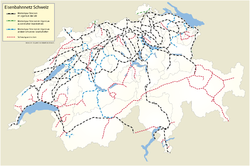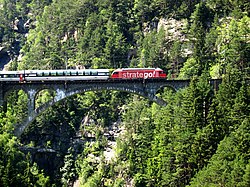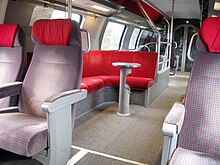Swiss Federal Railways
| File:SBB-CFF-FFS.svg | |
| Company type | State-owned company |
|---|---|
| Industry | Rail Transport |
| Founded | 1 January 1902 |
| Headquarters | , |
Key people | Andreas Meyer, CEO |
| Revenue | |
| Total assets | CHF 33.19 billion (2010) |
| Total equity | CHF 9.995 billion (2010) |
Number of employees | 28,143 |
| Divisions | Passenger, SBB Cargo, Infrastructure, Real Estate |
| Website | SBB CFF FFS |
 Railway network | |
 InterCity on the Gotthard Line | |
| Overview | |
|---|---|
| Dates of operation | 1 January 1902–present |
| Technical | |
| Track gauge | 1,435 mm (4 ft 8+1⁄2 in) |
| Electrification | 15 kV, 16.7 Hz Overhead line |
| Length | 3,011 km (1,870.9 mi) |
Swiss Federal Railways (German: Schweizerische Bundesbahnen, French: Chemins de fer fédéraux suisses, Italian: Ferrovie federali svizzere) is the national railway company of Switzerland. It is usually referred to by the initials of its German, French and Italian names, either concatenated as SBB CFF FFS, or used separately. The Romansh version of its name, Viafiers federalas svizras, is not officially used.[1][2][3]
The company is headquartered in Bern. Formerly a government institution, since 1999 it has been a special stock corporation with all shares held by the Swiss Confederation or the Swiss cantons.
Organization
Swiss Federal Railways is divided into three divisions and two groups:
- Passenger traffic
- Freight traffic (SBB Cargo AG)
- Infrastructure
- Real estate
- Core services (finances, personnel)
The corporation is led in an entrepreneurial manner. A performance agreement between Swiss Federal Railways and the Swiss Confederation defines the requirements and is updated every four years. At the same time the compensation rates per train and track-kilometre are defined.
Subsidiary SBB GmbH is responsible for passenger traffic in Germany. It operates the Wiesentalbahn and the Seehas services.
Further subsidiaries are Thurbo, RegionAlps, AlpTransit Gotthard AG, Cisalpino AG and TiLo (the latter in consortium with Italian authorities). The Swiss Federal Railways hold significant shares of the Zentralbahn and Lyria.
To take care of the historical heritage, the Stiftung Historisches Erbe der SBB ("SBB Historic") was founded in 2002. This foundation takes care of the historic rolling stock and runs a technical library in Bern, a historic archive, a photo archive and the SBB poster collection. (TM)
Figures

- Travellers per year (2010): 347 million [1]
- Freight per year: 49.3 million tons (2009)
- Length of railway network: 3011 km in standard gauge (until 2005 also 74 km metre gauge)
- Stations: 824
- Stations open to passengers: 760
- Stations with freight traffic: 452
- Companies connected to private sidings: about 2500
- Parking capacity at stations: 23,685 cars
- Employees: 28,143
- Punctuality (2009): 87% of all trains with less than 3 minutes of delay
- Subsidies for operation, maintenance of assets and construction investments (2010): 2.603 billion Swiss francs
The Swiss Federal Railways rail network is almost totally electrified. The metre gauge Brünigbahn was SBB's only non-standard gauge line, until it was out-sourced and merged with the Luzern-Stans-Engelberg-Bahn to form the Zentralbahn, in which SBB holds shares.
History

In the 19th century, all Swiss railways were owned by private ventures. The economic and political interests of these companies led to lines being built in parallel and some companies went bankrupt in the resulting competition. On 20 February 1898 the Swiss people agreed in a referendum to the creation of a state-owned railway company. The first train running on the account of the Swiss Confederation ran during the night of New Year's Day in 1901[clarification needed] from Zurich via Bern to Geneva, although 1 January 1902 is regarded as the official birth date of Swiss Federal Railways. In the meantime, the trains were run by the Swiss Confederation on behalf of the private companies.
The following railway companies were nationalised:
- Aargauische Südbahn (ASB)
- Bötzbergbahn (BöB)
- Schweizerische Nordostbahn (NOB)
- Schweizerische Centralbahn (SCB)
- Toggenburgerbahn (TB)
- Vereinigte Schweizerbahnen (VSB)
- Tösstalbahn including the Wald-Rüti Railway (WR)
- Wohlen-Bremgarten Railway (WB)
- Jura-Simplon-Bahn (JS) including the Brünigbahn (the latter in 1903)
Other companies were included later, and the rail network was extended. It is still growing today.
First class compartments were discontinued on 3 June 1956, and second and third class accommodation was reclassified as first and second class.
In 1982 SBB introduced the Taktfahrplan ("clockface timetable"), with trains for certain destinations leaving every 60 minutes, greatly simplifying the timetable.

On December 12, 2004 the first phase of Bahn2000, an ambitious programme to improve the company's services, was put into effect.[4] The core element was the Zurich-Bern-Basel triangle, where travel times between the cities was reduced to under one hour, resulting in good connections from these stations for most trains. Some connections between cities got two trains in each direction per hour or more, and the S-Bahn services were intensified to four or more trains per hour. Because of these changes 90% of the timetable was changed, 12% more trains were scheduled and travel times generally improved. It was the greatest timetable change since the introduction of the Taktfahrplan.
For this change to be possible, large parts of the infrastructure had to be modified and many stations were rebuilt, for instance the line from Ziegelbrücke to Sargans or Bern main station which got the "wave of Bern", a platform over the tracks to provide better access to the platforms and the city centre.
On 22 June 2005 a short circuit on a long distance power transmission line in central Switzerland led to a chain reaction. The entire Swiss Federal Railways network was out of service during rush hour and an estimated 200,000 people and 1500 trains were stuck at stations or somewhere on the track. It turned out that the SBB power transmission network was overloaded and did not provide enough redundancy to tolerate the shutdown of the 4 cable Amsteg-Steinen power line due to construction works. So, the power grid was split in two parts, the northern half being overloaded and the southern half having a load reduction for the SBB power plants are situated in the southern part (the Alps), while most of the power is needed in the northern part (the Swiss plateau). The situation led to high voltage fluctuations and finally breakdown and emergency shutdown of the entire power supply.
In the same year, the Swiss Federal Railways received the Wakker Prize, an award given out by the Swiss Heimatschutz (an institution aiming to preserve the view of cities and villages in terms of buildings), which is usually only granted to communes, for their extraordinary efforts. The Swiss Federal Railways have many high-class (listed) buildings from well-known architects such as Herzog & de Meuron, Santiago Calatrava or Max Vogt.
In May 2010, SBB's first integrated network control centre opened in Lausanne, to supervise all of SBB's network in the French-speaking part of Switzerland. Another integrated control centre will be opened in Zurich.[5]
All trains and most buildings have been non-smoking since the timetable change of 11 December 2005.
By the end of 2006, the corporation was handed over from the long-term CEO Benedikt Weibel to his successor Andreas Meyer.
Clock

The Swiss Federal Railways clock designed by Hans Hilfiker has become a national icon.[6] It is special in that it stops for just over a second at the end of each minute, to wait for a signal from the master clock which sets it going again — thus keeping all station clocks synchronized.[7]
On September 20, 2012, Swiss and world media reported that the design of this clock had been copied without prior permission by Apple Inc. and used in the iOS 6 clock application on Apple devices.[8] On October 12, 2012, SBB published a statement saying that the two companies had come to an agreement, resulting in Apple Inc. licensing the clock's design, without giving further detail.[9]
Rolling stock

Mainline locomotives
Steam engines of the early days of the Swiss Federal Railways were, among others, the Ed 2x2/2, E 3/3, A 3/5, B 3/4 and C 5/6.
The first electric trial runs using single-phase alternating current were made in 1903 on the line Seebach - Wettingen together with the Maschinenfabrik Oerlikon (MFO), using the future Ce 4/4 locomotives ("Eva" and "Marianne"). The electrification of the network started 1919, motivated by the coal shortages during the First World War, and new electric locomotives were introduced: Ce 6/8 II/Ce 6/8 III "Crocodile" (1920/1926), Be 4/6 (1920), Be 4/7 (1921), Ae 3/6 I (1921), Ae 3/6 II (1924), Ae 3/6 III (1925), Ae 4/7 (1927) and Ae 4/6 (1941). A shift of paradigms happened in 1946, when the age of modern bogie-based locomotives without trailing axles started with the Re 4/4 I (1946), followed by the Ae 6/6 (1952), Re 4/4 II/Re 4/4 III (1964/1971), Re 6/6 (1972), Re 450 (1989) and Re 460/Re 465 "Lok 2000" (1992/1994).
The delivery of the last Re 465 marked the end of the Swiss locomotive industries with the closure of the Swiss Locomotive and Machine Works. The Swiss Federal Railways were split into three divisions - Passenger, Freight and Infrastructure, each with independent locomotive supply policies. Because the Passenger division got all modern Re 460 and opted for multiple unit trains, mainline locomotives were bought only by the Cargo division, namely Re 482 "Traxx F140 AC" (2002), Re 484 "Traxx F140 MS" (2004) and Re 474 "ES64 F4" (2004).
Multiple units

The first multiple units originated from the Seetalbahn, which was formed in 1922. Larger series were uncommon until after 1950: Be 4/6 (1923), De 4/4 (1927), BDe 4/4 (1952), RBe 4/4 (1959), RBDe 560 "NPZ" (1984) and RABe 520 "GTW" (2002).
The first multiple unit trainsets were bought for the introduction of the Taktfahrplan on the line Zurich–Meilen–Rapperswil in 1967: RABDe 12/12 "Mirage" (1965) and RABDe 8/16 "Chiquita" (1976). Multiple unit trainsets started to prevail in the 1990s, especially for commuter traffic: RABDe 500 "ICN" (1999), RABe 523 (et al.) "FLIRT" (2004) and RABe 514 "DTZ" (2006). While locomotive-hauled trains are rarely seen in commuter traffic nowadays, they are still the usual in intercity traffic.
Some of the most popular historic multiple unit trainsets are the Roten Pfeile ("Red Arrows") (RAe 2/4) and the "Churchill-Pfeil" (RAe 4/8). In international traffic the Trans-Europ-Express (TEE) diesel trainsets appeared in 1957, but were replaced by four-systems electric trainsets RAe TEEII in 1961.
On 12 May 2010, Swiss Federal Railways announced its largest order of rolling stock; buying 59 double-deck EMUs from Bombardier, plus an option for another 100 trainsets. The new trains will be delivered from 2012 to 2019.[10]
Languages

SBB operates in all three official languages (Romansch is categorised as a national language, and is not an official one. The Romansh-speaking part of Switzerland is served by the RhB in any event). Stations are usually named with the abbreviation corresponding to, and signposted exclusively in, the language of the locality, i.e. Basel SBB, Lausanne CFF. Trains are labelled "SBB CFF FFS".
Announcements for local trains are made in the local language, those for long-distance trains and for trains which cross the language border in both appropriate languages. Long-distance trains at major stations also have announcements in English.
Services

SBB has the following services:
- R: Regio (Regionalzug): stops at all stations
- S: S-Bahn/RER (Commuter train): same as Regio, but organized as a network around the major cities, with several lines and generally more frequent service.
- RE: RegioExpress
- IR: InterRegio,
- IC: InterCity: stops at major cities (Geneva, Lausanne, Fribourg etc.)
- ICN: InterCity Tilting Train Same kind of product as IC, but using tilting trains instead of standard/double-decked trains
- CityNightLine: specially equipped night trains to
- the Netherlands (from Zurich and Basel)
- Austria (from Zurich)
- Denmark (from Basel)
- Germany (from Zurich and Basel)
- Extra: Charter train or special train added when an exceptionally heavy traffic is expected.
Regional trains are sometimes operated by another Swiss railways operator (for example, the Bern S-Bahn services operated by the BLS AG.)
SBB also operates international EuroCity and EuroNight trains while within Switzerland, while Deutsche Bahn operates InterCityExpress services to, from, and (a few services) within the country. It also has a few TGV stations.
Tickets and pricing
Tickets for the trains are relatively expensive compared with other world rail ticket prices. There are two classes, second class and first class. Tickets are half-price for children not over 16 and holders of half fare cards. Tickets can be bought at automated ticket machines in all train stations or at ticket offices. Tickets are routinely checked, (particularly on IC, ICN, IR, and international [TVG, ICE, etc.] trains; checks on regional trains (particularly S-bahn) are more sporadic. Some RE routes are checked, or, as the Swiss call it, "controlled" (the system of ticket-checking is called the "Kontrollsystem"), more than others. [11] [12] Some ticket types and prices as of October 2012[update]:[13][14]
- Tickets between two long-distance destinations: These tickets allow a passenger to board a train between two destinations or a train which will make a transfer. The price of an adult second-class ticket between Zurich and Geneva is 82CHF.
- Tickets in Tariff zones: Switzerland is divided into Tariff zones, such as the ZVV in the Zurich Area, for local travel; two- or 24-hour tickets are available for one or more zones, and are valid on most forms of public transportation within the zones. A 24-hour second-class ticket for all zones in the Zurich Network costs 31.60CHF.
- Annual passes are available, requiring a photograph of the ticket-holder:
- Zone passes: These passes apply in Tariff zones and provide access to public transit in the zones paid for. Travel outside the tariff area can be added when necessary by purchasing a Anschlussbillet' (extension ticket). The yearly cost for an adult in second-class with all zones in the Zurich Network is 2043CHF.
- GA Travelcard: this ticket grants access to all public transportation in Switzerland. The yearly cost for an adult in second-class is 3350CHF.
- Half-fare card: a card which entitles people over the age of 16 to buy tickets (except yearly tickets) at half-price. The cost of a one-year half-fare card is 175CHF from December 9, 2012. [15]
- Extension Tickets: these tickets extend a zone pass or other ticket to apply in more zones for up to 24 hours. A ticket for a second class, 24 hour, 1-2 zone upgrade is 8.20CHF in the Zurich area.
There are many other tickets such as Night tickets, Youth cards, several day tickets, punch cards, and special tickets for tariff zones, but the above are the most common.
Airline codeshare
- SBB codeshares with American Airlines and Swiss International Airlines out of Zurich International Airport in Zurich.
See also
- Gotthardbahn
- Hans Hilfiker
- List of stock used by Swiss Federal Railways
- PostBus Switzerland
- Rail transport in Switzerland
- Swiss Travel System
Notes and references
- ^ "SBB: The company". SBB.
- ^ Tyler Brûlé (30 March 2012). "On track to beat the Monday blues". Financial Times.
- ^ "SBB calls tenders for Gotthard high speed trains". Railway Gazette International. 17 April 2012.
- ^ Murray Hughes (1 May 2005). "Bahn 2000 is working". Railway Gazette International.
- ^ "Supervising Swiss tracks date=26 June 2010". Railway Gazette International. Retrieved 2010-07-21.
{{cite web}}: Missing pipe in:|title=(help) - ^ "Remarkable clocks and watches: the Swiss railway clock". swissworld.
- ^ "Swiss Railway / Mondaine puzzler". Watchuseek Forums.
- ^ "Apple kopiert die berühmte SBB-Uhr". Tages Anzeiger.
- ^ "SBB und Apple schliessen Lizenzvereinbarung ab". SBB.
- ^ "Bombardier wins SBB double-deck train order". Railway Gazette International. 2010. Retrieved 2010-05-12.
- ^ http://www.sbb.ch/bahnhof-services/dienstleistungen/kundendienst/reisen-ohne-gueltigen-fahrausweis-haben-sie-ein-billett-geloest.html
- ^ http://www.sbb.ch/en/station-services/services/sbb-customer-service/travelling-without-a-ticket.html
- ^ "SBB Timetable".
- ^ "ZVV Tickets".
- ^ http://www.sbb.ch/en/travelcards-and-tickets/railpasses/half-fare-travelcard/1-2-or-3-year-half-fare-travelcard.html
External links
![]() Media related to SBB-CFF-FFS at Wikimedia Commons
Media related to SBB-CFF-FFS at Wikimedia Commons
- Railway companies of Switzerland
- Rail transport in Switzerland
- Transport in Switzerland
- Railway companies established in 1902
- Railteam
- Government-owned companies of Switzerland
- Federal Department of Environment, Transport, Energy and Communications
- Companies owned by the federal government of Switzerland
- 1902 establishments in Switzerland
